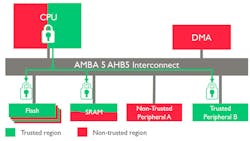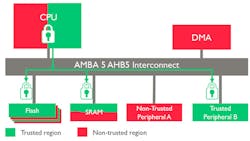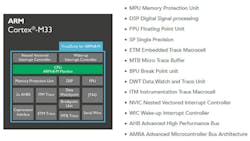Cortex-M23 and M33 Incorporate Latest TrustZone Features
ARM’s latest Cortex-M platforms using the ARMv8-M architecture are out. They include the Cortex-M23 and Cortex-M33 families, and they specifically target applications for the Internet of Things (IoT). One of the main features of the ARMv8-M architecture is the ARM TrustZone security support (Fig. 1) with its secure and non-secure states.
The Cortex-M23 targets the same space as the Cortex-M0+ very-small, ultra-low-power systems, while the Cortex-M33 targets the higher-end Cortex-M3 space. A platform for the higher-end Cortex-M7 is likely in the works, although the Cortex-M33 has floating point support.
The two platforms share a number of features, including the new instruction set support for TrustZone that is integrated with the new memory protection unit (MPU). The MPU provides 16 isolation regions that can be shared among applications. The region protection extends to peripherals. Features from the ARMv7-M include enhanced conditional compare and branch instructions, as well as immediate move instructions. There is also improved atomic support for C11/C++11 load-acquire and load-release instructions for more efficient semaphore handling.
The platforms differ in implementation, with a two-stage pipeline for the Cortex-M23 and a three-stage pipeline for the Cortex-M33. This provides the Cortex-M33 with more performance. The Cortex-M33 has additional options, such as a floating point unit (FPU) and DSP instructions (Fig. 2).
Chips based on the Cortex-M23 and Cortex-M33 are still in the works, but turnover to sampling products from ARM licensees is expected to be early next year.
About the Author
William G. Wong
Senior Content Director - Electronic Design and Microwaves & RF
I am Editor of Electronic Design focusing on embedded, software, and systems. As Senior Content Director, I also manage Microwaves & RF and I work with a great team of editors to provide engineers, programmers, developers and technical managers with interesting and useful articles and videos on a regular basis. Check out our free newsletters to see the latest content.
You can send press releases for new products for possible coverage on the website. I am also interested in receiving contributed articles for publishing on our website. Use our template and send to me along with a signed release form.
Check out my blog, AltEmbedded on Electronic Design, as well as his latest articles on this site that are listed below.
You can visit my social media via these links:
- AltEmbedded on Electronic Design
- Bill Wong on Facebook
- @AltEmbedded on Twitter
- Bill Wong on LinkedIn
I earned a Bachelor of Electrical Engineering at the Georgia Institute of Technology and a Masters in Computer Science from Rutgers University. I still do a bit of programming using everything from C and C++ to Rust and Ada/SPARK. I do a bit of PHP programming for Drupal websites. I have posted a few Drupal modules.
I still get a hand on software and electronic hardware. Some of this can be found on our Kit Close-Up video series. You can also see me on many of our TechXchange Talk videos. I am interested in a range of projects from robotics to artificial intelligence.




